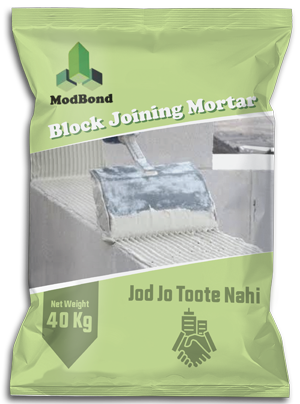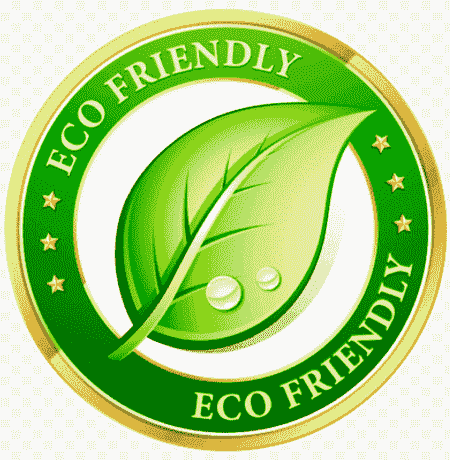ModBond –
ReadyMade
Mortar

ModBond - ReadyMade Mortar
Ready to mix | Thin bed solution | High bond strength | Self-curing
AAC BLOCK ADHESIVE Mod Bond is a factory prepared blend of carefully selected raw materials, Portland cement and graded aggregates and polymers or dolomites. Designed for use with
water to produce high strength thixotropic mortar for laying aerated light weight concrete, fly ash bricks, cement hollow blocks, cellular concrete blocks or smoothing over the block work surface in layers of 3mm to 5mm thickness, that meet and exceed the requirements of National and International Standards.
Thixotropic is a time-dependent shear thinning property. Certain gels or fluids that are thick (viscous) under static conditions will flow (become thin, less viscous) over time when shaken, agitated, or otherwise stressed (time dependent viscosity).
Coverage: Normally, 30-35 kg of adhesive is required for mounting one cubic meter AAC block in 2-3 mm thick mortar. Coverage is based on smoothness and evenness of the substrate, size of blocks used and the thickness of mortar used
Suitable Substrate:
- Aerated light weight blocks
- Concrete blocks
- Cement mortar blocks/bricks
- Concrete hollow blocks
- Cellular concrete blocks
- Fly Ash bricks
Package: 40 Kgs bag
Shelf Life: 12 months from the date of manufacturing in a sealed condition.

Get Requirement Estimate
Technical
Specifications
| Parameter | Specification |
| Colour/Appearance | Grey and Fine Powder |
| Bulk Density | 1450-1550 Kgs per Cubic Meter |
| Pot life | Upto 90 minutes |
| Open time | 10-15 minutes |
| Split Tensile Strength, N/mm2 @ 28 days | 0.44 N/mm2 |
| Tensile adhesion strength @ 28 days | Initial > 0.5 Mpa, After immersion > 0.5 Mpa |
| Compressive strength @ 28 days | 12 MPA to 18mpa |
How to Install
Using ModBond is as simple as using Fevicol. Just make sure that these steps are kept in mind while using it.
1. Substrate
The surfaces on which the block work has to be done shall be sound and confirm to good Design, Rigid, clean and free of dirt, oil, grease, curing compounds, form release agents or loose plaster and paint For economy the surfaces should be level and true within 1.5mm in 1.0m.
2. Surface Preparation
- Ensure the substrate is clean and free from impurities like dust, dirt, debris, oil, grease, curing agents, existing paints, loose plaster etc.
- Dampen the surface before application of adhesive
- Clean the back of block for any dust or coating.
3. Mixing
The product can be mixed by hand or slow speed electric drill mixer (less than 300 rpm). Pour water in a clean container and then add
the AAC Block adhesive until the mixture becomes creamy and plastic. Do Not Over mix. Leave the mix to slake for 5-10 min and remix before use. Mix only sufficient quantity of adhesive for immediate need.
4. Proportion
Approximately 1 bag of 40 Kg of AAC Block Adhesive with 10-12 ltrs of Water. Adjust quantity of liquid to obtain proper consistency.
5. Installation
Wet the surface and remove the excess water before applying the adhesive. Ensure the area is shaded from sunlight. The adhesive shall be applied with the flat side of the trowel using a scraping motion to work the material into good contact with the surface to be covered. Additional mortar is then applied with the notched edge of the trowel.
6. a) Application - Thin bed mortar for laying blocks
Before placing mortar, ensure the block work to be dry and surfaces cleaned properly. Place the mixed mortar on the block work in thin layers of 2 to 5mm (or as required by engineers at site) using trowel and place the next layer of blocks on the mortar. Keep joints between the blocks as required by the site engineers and fill the joints with the mixed mortar, using a trowel. Check the plumb of the wall while laying the blocks to keep the walls perfectly vertical to the plumb.
6. b) Application - As adhesive to install tiles
AAC Block Adhesive can be used as a thin- set adhesive to install tiles on AAC Block/Fly ash brick walls. Use a suitable notch trowel to achieve desired thickness of adhesive for
installation of tiles on the wall. The most important standard to keep in
mind is to ensure that the piece of block is completely bedded in the mortar or adhesive with 100% coverage after Beat in. Excess mortar on adhesive shall be cleaned from the surface of the blocks with wet cloth or sponge while the mortar is fresh.
We've Been here for over 20 years
We have an experience of more than 20 years in the fly ash industry, and are dedicated to be the driving force of change in the construction material market to make it more inclusive for the nature.
